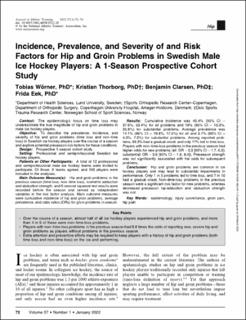| dc.contributor.author | Wörner, Tobias | |
| dc.contributor.author | Thorborg, Kristian | |
| dc.contributor.author | Clarsen, Benjamin Matthew | |
| dc.contributor.author | Eek, Frida | |
| dc.date.accessioned | 2022-03-25T17:24:06Z | |
| dc.date.available | 2022-03-25T17:24:06Z | |
| dc.date.created | 2021-06-03T14:07:26Z | |
| dc.date.issued | 2022 | |
| dc.identifier.citation | Journal of Athletic Training. 2022, 57(1), Side 72-78. | en_US |
| dc.identifier.issn | 1062-6050 | |
| dc.identifier.uri | https://hdl.handle.net/11250/2987751 | |
| dc.description | This work is licensed under a Creative Commons Attribution 4.0 International License. | en_US |
| dc.description.abstract | Context: The epidemiologic focus on time loss may underestimate the true magnitude of hip and groin problems in male ice hockey players.
Objective: To describe the prevalence, incidence, and severity of hip and groin problems (time loss and non–time loss) in Swedish ice hockey players over the course of a season and explore potential preseason risk factors for these conditions.
Design: Prospective 1-season cohort study.
Setting: Professional and semiprofessional Swedish ice hockey players.
Patients or Other Participants: A total of 12 professional and semiprofessional male ice hockey teams were invited to participate. Of those, 9 teams agreed, and 163 players were included in the analyses.
Main Outcome Measure(s): Hip and groin problems in the previous season (time loss, non–time loss), isometric adduction and abduction strength, and 5-second squeeze test results were recorded before the season and served as independent variables in the risk factor analysis. Main outcome measures were cumulative incidence of hip and groin problems, average prevalence, and odds ratios (ORs) for groin problems in season.
Results: Cumulative incidence was 45.4% (95% CI = 37.6%, 53.4%) for all problems and 19% (95% CI = 13.3%, 25.9%) for substantial problems. Average prevalence was 14.1% (95% CI = 10.8%, 17.5%) for all and 5.7% (95% CI = 4.3%, 7.2%) for substantial problems. Among reported problems, 69.2% had a gradual onset, and only 17% led to time loss. Players with non–time-loss problems in the previous season had higher odds for new problems (all: OR = 3.3 [95% CI = 1.7, 6.3]; substantial: OR = 3.6 [95% CI = 1.8, 8.4]). Preseason strength was not significantly associated with the odds for subsequent problems.
Conclusion: Hip and groin problems are common in ice hockey players and may lead to substantial impairments in performance. Only 1 in 5 problems led to time loss, and 7 in 10 had a gradual onset. Non–time-loss problems in the previous season were a significant risk factor for new problems, whereas decreased preseason hip-adduction and -abduction strength was not. | en_US |
| dc.language.iso | eng | en_US |
| dc.subject | epidemiology | en_US |
| dc.subject | groin pain | en_US |
| dc.subject | hip pain | en_US |
| dc.subject | injury surveillance | en_US |
| dc.title | Incidence, prevalence, and severity of and risk factors for hip and groin problems in Swedish male ice hockey players: A 1-season prospective cohort study | en_US |
| dc.type | Peer reviewed | en_US |
| dc.type | Journal article | en_US |
| dc.description.version | publishedVersion | en_US |
| dc.rights.holder | © by the National Athletic Trainers' Association, Inc | en_US |
| dc.source.pagenumber | 72-78 | en_US |
| dc.source.volume | 57 | en_US |
| dc.source.journal | Journal of Athletic Training | en_US |
| dc.source.issue | 1 | en_US |
| dc.identifier.doi | 10.4085/1062-6050-0522.20 | |
| dc.identifier.cristin | 1913590 | |
| dc.description.localcode | Institutt for idrettsmedisinske fag / Department of Sports Medicine | en_US |
| cristin.ispublished | true | |
| cristin.fulltext | original | |
| cristin.qualitycode | 1 | |
